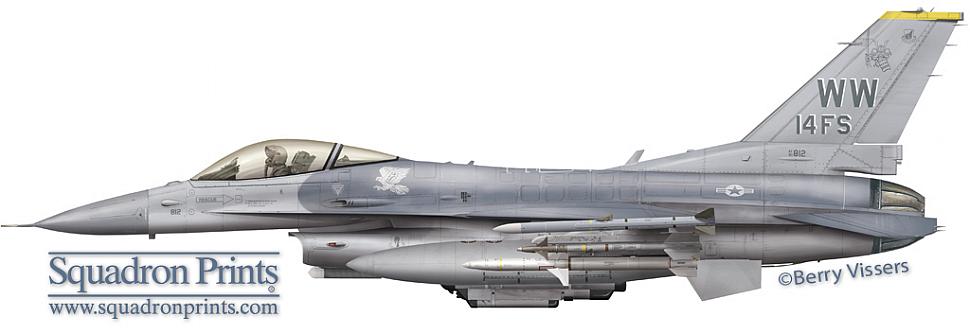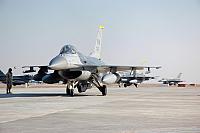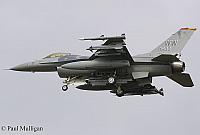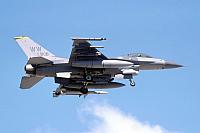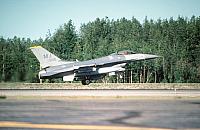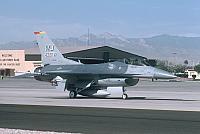 |
14th Fighter Squadron ( USAF PACAF)" Samurais" |
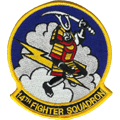 |
14 FS " Samurais" ( USAF PACAF) | |||
| Status: |
Active
|
|||
| Version: | F-16C/D block 50 | |||
| Role: | Multirole, SEAD | |||
| Tailband: | Yellow | |||
| Motto: | N/A | |||
| Badge: | N/A | |||
F-16 History
In the mid eighties the USAF decided that their presence in the Pacific area needed a boost. In the first place this was directed at strengthening their presence on the Korean peninsula, but since the 8th FW was already present on the island as well as numerous Korean units themselves, space was relatively limited. Therefore the USAF decided to strengthen their presence in Japan. This country didn’t have the disadvantages of Korea and modern infrastructure was already present. Two units were created under the newly formed 432nd TFW (later redesignated to 35th TFW), being the 13th and 14th TFS. The 14th was reactivated in 1987 receiving brand-new block 30 airframes tasked with air defense, with a limited attack duty as well.
The first airframes were received in 1987 with IOC being reached in early 1988. Those block 30 airframes came with a lot of advantages. They had a more powerful engine and the new APG-68 radar. New weapon systems were also installed and a nightly attack capability was added as well. The introduction of this type happened in parallel to the introduction with the 13th TFS.
Already in 1990 these airframes were again swapped for other ones. The block type stayed the same – being block 30 airframes – but they were of the so-called ‘big inlet’ version. With this modification the full extent of the General Electric F110 engine came into being, giving better overall performance of these jets. The mission of the squadron remained practically the same. These airframes became redundant with the Korean based 36th TFS, which was swapping them over with new block 40 jets at the time.
In 1994 the squadron was converted to the block 50 of the viper. In general this added some functionality again. More specifically this also meant that the Suppression of Enemy Air Defenses (SEAD) mission was added to the mission profile of the squadron. Over the years new electronics and weapon systems were introduced on these airframes, but their role remained the same for the past 18 years. This also meant that the entire fleet at Misawa AB was standardized on the same block type.
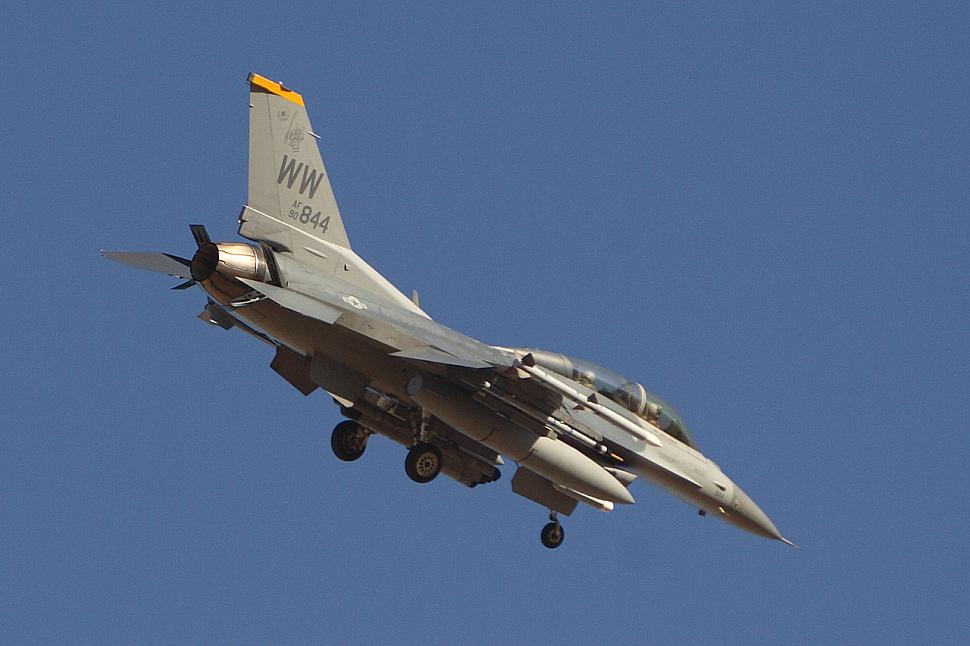
Aircraft Markings History
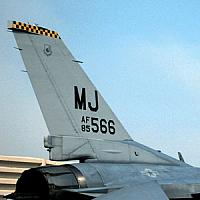
The tail consist of a black and yellow checkered tailband with the 'MJ' tailcode in the center - meaning Misawa Japan - and the serial underneath.
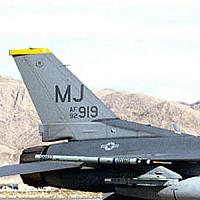
The general lay-out remained the same. The tailband changed color to yellow and a little PACAF logo was added beneath it.

The lay-out remained unchanged, but the tailcode was changed to 'WW', referring to the Wild Weasel mission of the squadron.

Yet again the lay-out remained unchanged. Above the tailcode the squadron mascot - a samurai - was added in toned down markings.
Unit History
- 1942: Activation of the squadron in Colorado Springs, Colorado
- 1942: P-38E/F-4 'Lightning' (part of 3 PG)
- 1942: P-38G/F-5 'Lightning'
- 1943: 'Spitfire' PR.XI (part of 3 PRG, Mount Farm [Eng.])
- 1943: 'Spitfire' PR.XI (part of 7 PRG)
- 1943: 'Spitfire' PR.XI (Chalgrove [Eng.])
- 1945: P-51D 'Mustang'
- 1945: P-51D 'Mustang' (Villacoublay [Fr.])
- 1945: P-51D 'Mustang' (Camp Shanks, New York)
- 1945: Disbanded
- 1947: Activation of the squadron in Binghampton, New York
- 1947: No aircraft assigned (part of 65 RG)
- 1949: Disbanded
- 1952: Activation of the squadron in Mitchell, New York
- 1952: C-46 'Commando' (part of 65 TCS)
- 1953: Disbanded
- 1966: Activation of the squadron in Bergstrom, Texas
- 1966: RF-4C 'Phantom II' (part of 75 TRW)
- 1967: RF-4C 'Phantom II' (part of 432 TRW, Udorn AFB [Thai.])
- 1975: Disbanded
- 1987: Activation of the squadron in Misawa [Jap.]
- 1987: F-16C/D 'Fighting Falcon' (part of 432 TFW)
- 1991: F-16C/D 'Fighting Falcon' (part of 432 FW)
- 1994: F-16C/D 'Fighting Falcon' (part of 35 OG)
Deployments
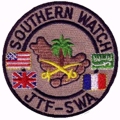 |
' Southern Watch' |
| Prince Sultan AB, Saudi Arabia [8 F-16s] (March of 1999 to May of 1999) | |
| Operation Southern Watch was an operation which was responsible for enforcing the United Nations mandated no-fly zone below the 32nd parallel in Iraq. This mission was initiated mainly to cover for attacks of Iraqi forces on the Iraqi Shi’ite Muslims. The squadron deployed a total of 150 personnel. | |
 |
' Northern Watch' |
| Incirlik AB, Turkey (October of 2001 to December of 2001) | |
| Operation Northern Watch was a US European Command Combined Task Force (CTF) who was responsible for enforcing the United Nations mandated no-fly zone above the 36th parallel in Iraq. This mission was a successor to Operation Provide Comfort which also entailed support for the Iraqi Kurds. | |
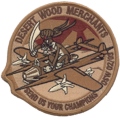 |
' Southern Watch' |
| Prince Sultan AB, Saudi Arabia [6 F-16s] (November of 2002 to March of 2003) | |
| The squadron was part of AEF-VII. With the US deciding to intervene in Iraq the operation changed names into Operation Iraqi Freedom, thus ending the AEF cycles of Southern Watch that were in place for years. | |
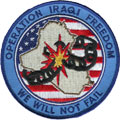 |
' Iraqi Freedom' |
| Prince Sultan AB, Saudi Arabia [6 F-16s] (March of 2003 to June of 2003) | |
| The squadron flew a mainstay of missions during the early days and weeks of the conflict. The unit was tasked at first because they were already in place for their Operation Southern Watch cycle. | |
 |
' Iraqi Freedom' |
| Balad AB, Iraq [13 F-16s] (January 19th, 2007 to October 12th, 2007) | |
| Twelve aircraft were sent from both 35th FW squadrons in January of 2007 in the roll of Close Air Support. This was a new roll for the 35th FW which largely trains for SEAD. The 14th FS flew the first half of the deployment under rotation AEF 5/6. With aircraft already in theatre, the 13th FS arrived to complete rotation AEF 7/8. On July 15th, 2007 F-16C #92-3901, from the 13th FS, was lost during takeoff from Balad AB, Iraq. The pilot ejected safely but the aircraft was a write off. At least two aircraft were sent to replace the one lost on July fifteenth. In the end the aircraft deployed flew 2,800 sorties spanning 11,500 hours. Returning pilots had to re-qualify for the SEAD mission. | |
 |
' Iraqi Freedom' |
| Balad AB, Iraq (September 18th, 2008 to January 11th, 2009) | |
| About 300 crew deployed to South West Asia with aircraft from both the 13th and 14th FS. Both squadrons succeeded each other, so that came in very handy. | |
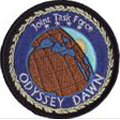 |
' New Dawn' |
| Balad AB, Iraq (August 29th, 2010 to January 7th, 2011) | |
| This operation replaced Operation Iraqi Freedom on September 1st, 2010 and is the part of the campaign intended to be the withdrawal from Iraq. | |
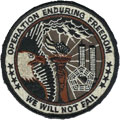 |
' Enduring Freedom' |
| Kandahar AB, Afghanistan (August 13th, 2012 to October 25th, 2012) | |
| This marked the final deployment of the 14th FS into operation for both Iraqi and Enduring Freedom. |
F-16 Airframe Inventory
- All 14 FS F-16s in our F-16 Aircraft Database (past and current aircraft)
- Current 14 FS F-16s in our F-16 Aircraft Database
Photos
The 14FS had solid yellow tail flashes before 1992. I was stationed in Misawa from 1990-1992, assigned to the 14th and at the time of my arrival, the were switching to the new jets with the "big mouth" inlet. At this time they had the yellow fin flashes.
Please note that the plural of Samurai is Samurai, not "Samurais."
Also a note on first tail colors of the 14TFS in 1987 - the black and yellow checkered band was located just below the top of the tail fin, going across the top of the rudder (see example of similar location of marking on 13TFS F-16A pictured on 13FS unit page on this website), and was later moved up to the top of the fin. Reason given for the move to the top was something to do with easier application/maintenance of the marking.
Please use this form to add any list any error or omissions you find in the above text.
Note: your comments will be displayed immediately on this page. If you wish to send a private comment to the webmasters, please use the Contact Us link.

